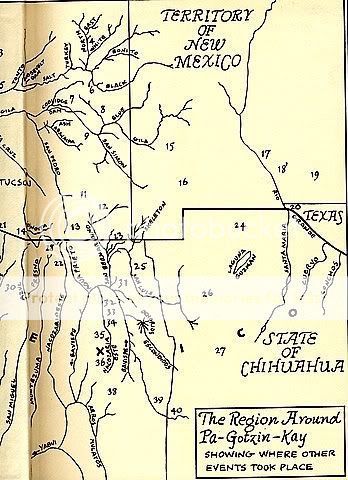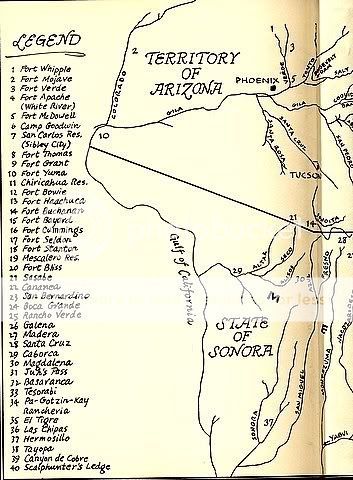Oroblanco said:
.....I do have to ask a favor, after all that cussing and admitting to jealousy etc, I would appreciate your opinions on what you read, if you would not mind sharing them?.....
Well, it's an interesting read with some new angles - well worth the investment.
To begin with, Stuart the writer (Zola Crosby) was a SE Arizona cowgirl who for 60 years researched and sought a number of Arizona lost mines. Her historical framework (verifiable history) is pretty solid - the place names, dates, known historical characters, etc. seems accurate. She apparently spent a lot of time and energy doing her homework before writing the 135 page, vanity press book (first 87 pages on the LAD). The book needs editing for spelling and grammar, but it's fairly well written.
She also provides a fair amount of anecdotal testimony that isn't so easy, or even possible, to verify. Ordinarily, this doesn't bother me because I know first hand the value that anecdotal evidence can provide. On the downside, she provides no sources for many of her facts, so it's tough to separate fact from wishful thinking. There are a number of hand-drawn maps and a few hard to see photos to accompany the story. Her solution of the LAD came to her in an epiphany one day as she was riding through Texas Canyon by car from Benson to Willcox, AZ.
Stuart's narrative of the LAD reads a bit like an historical novel, with plenty of dialog between the characters, rash assumptions to support theories ('it must have been a cloudy day'), full names of anonymous participants, etc. This sort of thing bothers me greatly - obviously made up material used to flesh out the story and support the conclusions. Most of the well-known LAD versions use the same technique, a big, big weakness in my opinion. In fact, the lesser-known anecdotal versions, which are more straightforward in many cases, gain credibility for this reason.
OK, cut to the chase, per Stuart. In 1864, Adams was freighting mining equipment from played out California mines to the Heintzelman silver mine in the Cerro Colorado Mountains west of Tubac, AZ, which is located on the Santa Cruz River 30 miles or so south of Tucson. Indians ran off his horses and burned his wagons per the well-known versions. Adams collected the horses and went back down river to the San Xavier Mission where Gotcho and the miners were. They convinced him to put up his twelve horses in exchange for leadership on the expedition to follow Gotcho to the gold.
They start out south on the Santa Cruz to the south end of the Santa Rita Mountains, then head northeasterly, in a very circuitous route (to avoid the Apaches) for six days. The Twin Peaks (where the gold was to be found) were first visible to the northeast from the pass over the Santa Rita range. These peaks turn out to be the well-known Dos Cabezas (Two Heads), east of Willcox. They camped on the sixth day near the top of Dragoon Wash, where they found the placer gold, were warned by Nana not to go higher in the canyon, etc., as is familiar in other versions of the LAD story.
The supply trip to the fort, the massacre, the cabin, the rich lode claim higher in the canyon, etc., are familiar details. The supply fort was Camp Grant on the San Pedro River, 75 miles to the north. The rich lode deposit later became the Old Terrible Mine, and was later renamed the Golden Rule Mine, located a few miles east of Dragoon, AZ. Gotcho's original target at the base of the Dos Cabezas, was never exploited by the miners who stayed and were killed in Dragoon Wash. Adams' escape, later searches, etc., is similar to other versions.
Stuart also offered interesting opinions on other Arizona lost mine stories. Briefly: the Peralta Mines were not in the Superstitions, but were at Rich Hill (Mesa Colorado del Oro). Jacob Waltz obtained a map to the diggings from one of the Peraltas associates in Mexico, a drinking buddy of his named Ludi, whom he murdered for the map. However, Waltz then misread the map. He mistook current Weavers Needle for the map's correct landmark, Picacho Soledad en Merito, located in the desert near the Vulture Mine - not in the Superstition Mountains. Waltz searched unsuccessfully from that point on in the Superstitions. This info came from Bud Dozier, a pal of the Stuart (Crosby, presumably) family and an aquaintance of Waltz. Dozier had allegedly seen the Peralta map and drew it out for the elder Stuart (Crosby) back in the day. Dozier was also associated with the Vulture Mine and claimed that the gold ore Waltz had in his possession was high-graded from the Vulture. Waltz was fired for the offense and later was again caught obtaining additional high-grade from miners there who he struck deals with. Waltz intimidated those who suspected him and was not called on the offense. Stuart claims the Lost Dutchman Mine is a fake.
Other Arizona lost mines, per Stuart: Pegleg Smith, 1860's - found (Harquahala Mine 1888); Lost Soldier, 1860's - found (King of Arizona Mine 1899); Doctor Thorne, 1860's - found (Gowan Mine 1879); Tenderfoot Mine, 1890's - found (Baker Mine, 1907); Nig-ger Ben, 1866 - never found.










 I have never even heard of that book title before, now will have to keep an eye open for it. I am jealous amigo Springfield!
I have never even heard of that book title before, now will have to keep an eye open for it. I am jealous amigo Springfield!  I do have to ask a favor, after all that cussing and admitting to jealousy etc, I would appreciate your opinions on what you read, if you would not mind sharing them? Thank you in advance, and as always there is absolutely no rush on my account.
I do have to ask a favor, after all that cussing and admitting to jealousy etc, I would appreciate your opinions on what you read, if you would not mind sharing them? Thank you in advance, and as always there is absolutely no rush on my account.


 ?
? 
